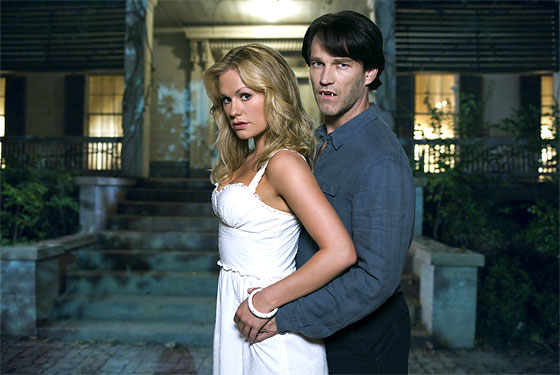
After months of nonstop promos, TV ads and billboards erected across the city, True Blood, HBOÔÇÖs marquee new show about vampires from Six Feet Under creator Alan Ball, finally premieres Sunday night. To which you might have said, ÔÇ£What? Another vampire-centric entertainment product?ÔÇØ
And itÔÇÖs true: Vampire-related books, TV shows, and movies seem to outnumber all other monster-related products by, oh, about 100 to 1. Why? Because vampires make for extraordinarily elastic metaphors. A werewolf represents our subdued animal instincts. Zombies stand in for mob psychosis. Frankenstein gets trotted out to represent technology versus mortality. And vampires ÔÇö well, they can represent pretty much everything else.
YouÔÇÖve got your louche, decadent school of vampires, personifications of our hedonistic id (the lace-wearing fops of Anne Rice; the romantic Byronic heroes of the Twilight series). YouÔÇÖve got the seedy, grungy, vampire-as-junkie school (see the vampire-noir novels of Charlie Huston, or the nasty splatterpunk masterpiece The Light at the End, by John Skipp and Craig Spector, about vampires in the NYC subway). YouÔÇÖve got your vampire-as-sexual-submission-fantasy (those late-night visits! Those penetrating fangs! Those damnable hypnotic eyes!) and your vampire-as-American-distrust-of-poncy-Europeans (ÔÇ£I vant to suck your bloodÔÇØ!). Vampires have even served, quite ingeniously, as a manifestation of adolescent ardor and angst. (Buffy the Vampire Slayer, come on down!)
On True Blood, Alan Ball is clearly intrigued by the vampireÔÇÖs metaphorical possibilities. The show is based on a series of novels by Charlaine Harris, from which BallÔÇÖs adopted the central premise: Vampires are coming out of the coffin, so to speak. They can now nourish themselves on synthetic blood so they no longer have to hunt humans. Now they simply want to be accepted for who they are. ÔÇ£Coming outÔÇØ? Simple acceptance? Clearly this is the showÔÇÖs central metaphor. One of the wittier moments in the opening credit sequence is a shot of a sign outside a church that reads ÔÇ£God Hates Fangs.ÔÇØ
So this is about vampires-as-the-gay-community, right? Well, not precisely. As BallÔÇÖs explained in interviews, these vampires are ÔÇ£struggling for assimilation and for equal rights.ÔÇØ They live in the South. TheyÔÇÖre plagued by small-minded bigots. No one wants their kids to date or, God forbid (literally), interbreed with the vampires. Yet the vampires are rumored to possess a forbidden sexual ferocity, so they draw female groupies called ÔÇ£fang bangers.ÔÇØ Maybe this isnÔÇÖt vampire-as-gay-person; itÔÇÖs vampire-as-African-American.
But wait  the shows also about religion. The vampires, with their demonic appetites, represent everything these God-fearing people have been taught to fear. The opening credits for the show is a stylish mash-up of hip-grinding southern vixens and ecstatic religious fanatics. So . were back to vampire-as-libidinous-succubus? But maybe gay. And black.
ItÔÇÖs not that Ball has to hit us over the head with a hammer in order to drive home his allegorical nail. In part, the showÔÇÖs metaphor diffusion simply hints at the rich vein of the vampire mythology, which can be mined for all manner of, er, biting commentary. WeÔÇÖve been taught to see all kinds of metaphors as soon as someone bares his fangs. Maybe Ball believes that sometimes a vampire is just a vampire, and heÔÇÖs not worried that, so far, the metaphors are pretty muddy. But clearly, on True Blood, the vampires are supposed to stand in for something. On the early episodes, at least, they can represent almost anything, which means they wind up not meaning much at all.

